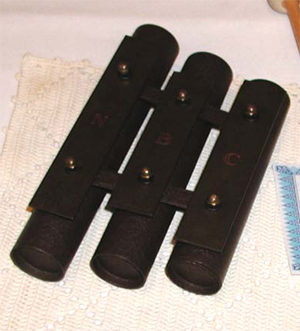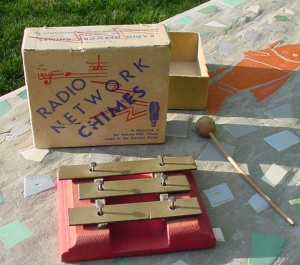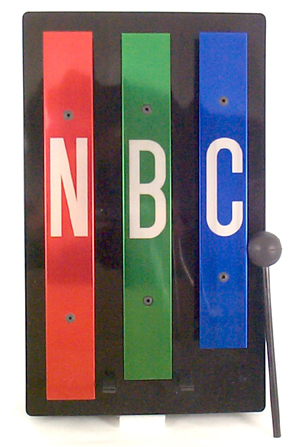promotional sets of nbc chimes
During the late 1930s and early 1940s, one of the busiest men at the National Broadcasting Company was its Advertising and Promotions Director, the Englishman E. P. H. James. Known as “Jimmy” to fellow NBC staffers, James was responsible for at least three outdoor installation of NBC Chimes that rang out over public squares, as well as two sets of chimes sold to the public—one as a souvenir (also given out to railroads for use on their dining cars), and one sold to children as a toy.

In an April 17, 1941 paper titled “Public Exploitation Of NBC Chimes”, James recounted that during late 1937 and early 1938 a deal was worked out with NuTone Chimes of Cincinnati, makers of electrical door chimes, for the manufacture of small hand–held sets of souvenir chimes. These were brown in color, had three plates (stamped n b c) mounted over tubular resonator chambers, and were sold to the public through the RCA publication Listen and through department stores.

On July 15, 1938 James began supplying these chimes in quantities to the Baltimore and Ohio Railroad for their dining cars. The New York Central was similarly equipped on August 8 of that year, and shortly thereafter the Pennsylvania Railroad and several other short–run railroads and coastal steamship lines were supplied with these chimes. James notes in his memo that during the period from March 1938 through January 1941, he purchased a total of 4,300 of these chimes from NuTone, and that NuTone had supplied several gross to department stores.
James received a memo from R. H. White in Detroit, dated June 24, 1938, in which White informed him that the wife of the head of a major advertising agency was enjoying her promotional chimes very much. White had given another chime to the president of General Motors, and this same ad agency wife told White that not only were the chimes in use within the palatial dining room of the GM President, but that this president had a married daughter who had been trying for weeks to talk her mother out of the chimes—to no avail. White concludes with tales of two other GM executives, and ends his letter with “Boy, you got something in ‘them there’ chimes!”.
James worked out another arrangement with NuTone around the same time, for the promotion of an electromechanical door chime signal marketed as NuTone Radio Chimes. On February 16, 1938, James advised J. Ralph Corbett of NuTone that legal clearance had been given for NuTone to state that by pressing the correct sequence of tones, an exact duplicate of the famous NBC Chime tones could be produced. This consent came with stipulations, among which was the express understanding that “no rights are included under which any radio station may broadcast our chimes”, and that no representation be made that NBC was in any way associated with the manufacture or sale of the NuTone Radio Chimes.

Over the Spring and Summer of 1938, E. P. H. James also negotiated with one J. Hugh McQuillen of the Schoenhut Manufacturing Company in Philadelphia, for the production and sale of toy chimes based on the three notes used for the NBC Chimes. The initial correspondence notes that while another manufacturer had contracted to produce full–sized chimes for home and office use (this would have been NuTone with their hand–held souvenir chimes), since these chimes would retail for two dollars or more it would not seem like duplication to authorize the production of toy chimes, which were considerably less expensive. In fact, the final retail price of the toy Schoenhut chimes was thirty–five cents.
James authorized Schoenhut to claim that these toy chimes were “miniatures of the famous NBC Chimes” but asked that the box not imply an exact replica. It was noted that these chimes would sound one octave higher than the actual NBC Chimes (the Deagan hand–held chimes also sound one octave higher than the mechanical Rangertone NBC Chimes), and it was advised that the tones be kept as close as possible to G, E, and C of concert pitch. The original box design carried artwork of an RCA 44B microphone with an NBC flag; NBC’s Legal Department declined permission to put the letters NBC anywhere on the microphone and suggested using SMC (for Schoenhut Manufacturing Company) instead. The name of the toy was also changed to “Miniature Radio Network Chimes” rather than “NBC Radio Chimes”. A letter from McQuillen dated July 1, 1938 indicates that all necessary revisions had been completed and that the toy was ready to be marketed at thirty–five cents each. The letter thanks James for his “valuable assistance in securing the National Broadcasting Company’s approval of our package”.

In October of 1953 David Sarnoff approved a new graphic trademark for NBC, that of three chime bars colored red, green, and blue, signifying the advent of color television. This trademark went into official use on January 1, 1954. Shortly thereafter a new souvenir chime was sold under license by Carroll Chimes, Inc. of New York. This product was permitted an NBC microphone on its box, as well as the legend “The Chimes You Hear From Coast To Coast”.
These chimes came in several models. The Standard size measured thirteen inches long by eight inches wide by two and five–eighths thick, and could be had either with red, green, and blue chimes as illustrated on the right, or in a deluxe version with gleaming chrome bars. The Junior size was available only in red, green, and blue, and measured six inches long by four inches wide by one and five–eighths inches thick. Presumably these smaller chimes sounded one octave higher than the larger model.
A booklet included with the chimes was a model of advertising hyperbole. As with earlier souvenir NBC chimes sold to the public, the chimes were arranged on the box so that one could sound the correct tones by striking the first, second, and third chimes. Unlike the manufacturers of the earlier chimes, Carroll actually developed an alloy that would permit the three chime bars to be gradated in size, rather than having the middle chime bar be the shortest of the three. The booklet dismissed with contempt the “ordinary old style chimes”, such as the Deagan chimes employed two decades earlier on the NBC networks, because on these “an imitation of the NBC sound sequence could only be produced by striking the bars in progression of 1–3–2, and such imitated tones were in an entirely different musical key than those of the genuine NBC sound sequence”.
This assertion was technically true, but through no fault of the earlier chimes. As explained elsewhere on this site, the original NBC three–tone sound sequence was sounded on a J. C. Deagan No 20 chime, on which the first, third, and second chime plates sounded the notes C A F. The notes did not become G E C until the development of the mechanical Rangertone chimes machine. However, the booklet that accompanied the Carroll chimes boasted that the chimes were designed by the eminent acoustic research engineer Clair Omar Musser. Musser had only recently left the employ of the J. C. Deagan Company, where for many years he had been the head of the tuned percussion department, and had set up his own competing firm to manufacture vibraphones and other instruments. Since the original Deagan chimes that sounded the original NBC triad were still in production, perhaps Musser felt the need to assert some sort of superiority with this instrument of his own design.
The exact pitch of the chimes is given in the booklet (G=195.9Hz, E=329.6Hz, C=261.6Hz), and the chimes were all but warranted to correspond so closely to the sound of the NBC Chimes as broadcast over the air as to be indistinguishable from the broadcast version.
chimes both on and in the air:
outdoor nbc chimes installations
While busy with souvenir and toy chimes over the summer of 1938, E. P. H. James was also working on installing an outdoor sound system that would play the NBC Chimes over a loudspeaker system, permitting the signal to be heard throughout Rockefeller Center. This went into operation on Thursday, August 11, 1938, and was hailed in a press release as the Big Ben of New York. This press release stated that the chimes marked each hour between 8:00am and 1:00am throughout Radio City. The system was described as having a loudspeaker, three small clocks, and a large ornamental clock in the south façade of the International Building. The first small clock turned the chime system on at 8:00am and off at the following 1:00am, and the second clock switched the loudspeaker on right before the hour, and turned it off after the chimes had sounded. A third clock, in NBC’s Master Control, closed a contact which set the Rangertone Chimes in motion, producing the same NBC Chimes over the plaza as the listeners would have heard over their radios. (This was not the main Rangertone Chime used on the network, but rather a secondary one kept in case of a failure with the main Chimes machine.) This innovation was so well received that a similar installation was soon set up in the Merchandise Mart in Chicago, where NBC’s Chicago operations were located.
James wasted no time in looking for additional places to install his outdoor chimes; however, an outdoor installation relaying the sound of the Rangertone chimes was not without its drawbacks. A particular anomaly in the design of the Rangertone chimes was that after the last note was sounded, the circuit was automatically broken—thus biting off the resonance of the last note before it had died away. This was not much concern on the radio, but by September 2, James complained that this abrupt cutoff impaired the full effectiveness of the outdoor chimes. In a September 9 memo to Oscar Hanson, then busy setting up the NBC studios in Hollywood, C. A. Rackey voiced his concerns about using Rangertone chimes for the outdoor installations. “In the first place”, Rackey stated, “an outdoor chimes system should be entirely separate from any broadcasting apparatus. Secondly, a multiple reed type of chime such as the Rangertone should not be considered. We should use instead the single reed chime arrangements as developed by RCA, which are superior in every way except in the matter of rapid damping of the sustained tones”. In his letter Rackey noted that RCA had promised to provide him with a sample of their chimes reeds for demonstration purposes.
By May 22, 1939, Rackey was still trying to get a satisfactory chimes machine from RCA, and had determined that such a device would cost under $100, as opposed to the Rangertones which cost about $500 per machine. Rackey noted with some dismay that RCA was “unwilling to do more than some spare time work on a device for which they have no definite order and for which, at best, the market is very limited”. In this letter of May 22, 1939 to E. P. H. James, Rackey did note that “our own Development Group has devised an acceptable chimes machine using vacuum tubes only, which would probably come within the price range of the RCA model”.
It was this vacuum tube chime, invented by NBC engineer J. L. Hathaway, that went into service in Times Square on April 27, 1940. Through an arrangement between NBC and advertising sign magnate Douglas Leigh, this set of chimes was placed inside a giant Gillette clock in Times Square. A press release explained:
“…there is nothing to strike, and no bells to ring. And it’s not done with mirrors. In fact, the chimes are not really chimes at all, but amplified oscillations in radio tube circuits…The new chimes differ sharply from the old type still in use on the networks, which produces the initial sounds from steel reeds plucked by a rotating cylinder. Under the old system, the three notes heard are made up of eight partial notes. These 24 partials are tuned to perfection by an oscilloscope and standard frequency oscillators. Tuning of new chimes is vastly simplified in that it is impossible for the individual notes to get out of tune, and initial tuning is accomplished by simple electrical adjustments.”
The press release quoted Dr. O. H. Caldwell, editor of Radio Today, as saying that “each of the three notes is a rich tone with some harmonics which heighten the musical relish”.
Advantages in the new chimes were apparent for on–air use as well, and over the next decade these electronic chimes were phased in and eventually all but replaced the Rangertone machines in daily use. The Rangertone machines were not completely eliminated, however—in fact, blueprint fragments of the Rangertone machine made in the 1950s still exist, and these go so far as to specify parts suppliers and processes used in manufacturing the spring steel from which the Chimes Machine reeds were made.